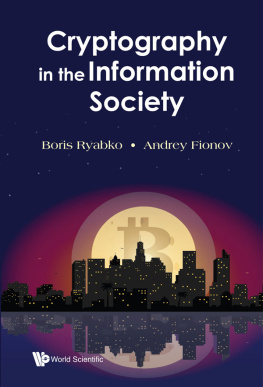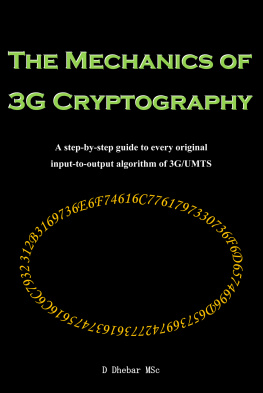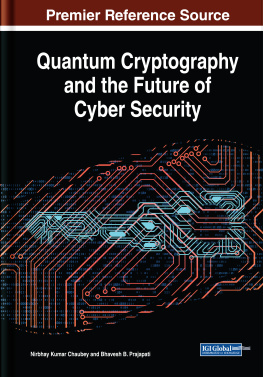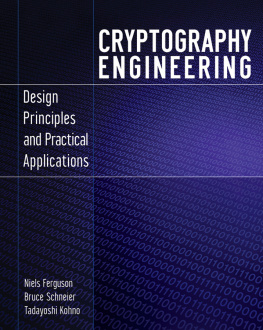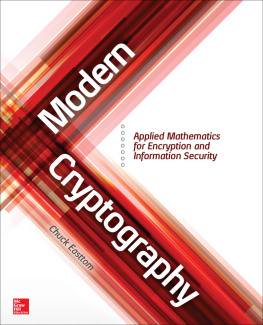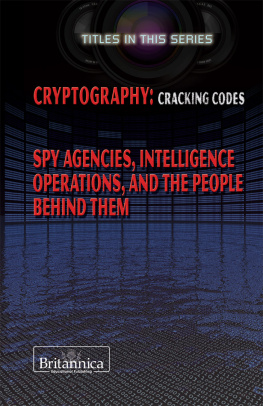Ryabko Boris - Cryptography In The Information Society
Here you can read online Ryabko Boris - Cryptography In The Information Society full text of the book (entire story) in english for free. Download pdf and epub, get meaning, cover and reviews about this ebook. year: 2021, publisher: World Scientific Publishing Company, genre: Children. Description of the work, (preface) as well as reviews are available. Best literature library LitArk.com created for fans of good reading and offers a wide selection of genres:
Romance novel
Science fiction
Adventure
Detective
Science
History
Home and family
Prose
Art
Politics
Computer
Non-fiction
Religion
Business
Children
Humor
Choose a favorite category and find really read worthwhile books. Enjoy immersion in the world of imagination, feel the emotions of the characters or learn something new for yourself, make an fascinating discovery.
- Book:Cryptography In The Information Society
- Author:
- Publisher:World Scientific Publishing Company
- Genre:
- Year:2021
- Rating:4 / 5
- Favourites:Add to favourites
- Your mark:
- 80
- 1
- 2
- 3
- 4
- 5
Cryptography In The Information Society: summary, description and annotation
We offer to read an annotation, description, summary or preface (depends on what the author of the book "Cryptography In The Information Society" wrote himself). If you haven't found the necessary information about the book — write in the comments, we will try to find it.
Cryptography In The Information Society — read online for free the complete book (whole text) full work
Below is the text of the book, divided by pages. System saving the place of the last page read, allows you to conveniently read the book "Cryptography In The Information Society" online for free, without having to search again every time where you left off. Put a bookmark, and you can go to the page where you finished reading at any time.
Font size:
Interval:
Bookmark:


Highly Recommended Titles
Cryptology for Engineers: An Application-Oriented Mathematical
Introduction
by Robert Schmied
ISBN: 978-981-120-804-1
ISBN: 978-0-00-098922-2 (pbk)

Published by
World Scientific Publishing Co. Pte. Ltd.
5 Toh Tuck Link, Singapore 596224
USA office: 27 Warren Street, Suite 401-402, Hackensack, NJ 07601
UK office: 57 Shelton Street, Covent Garden, London WC2H 9HE
Library of Congress Control Number: 2020949542
British Library Cataloguing-in-Publication Data
A catalogue record for this book is available from the British Library.
CRYPTOGRAPHY IN THE INFORMATION SOCIETY
Copyright 2021 by World Scientific Publishing Co. Pte. Ltd.
All rights reserved. This book, or parts thereof, may not be reproduced in any form or by any means, electronic or mechanical, including photocopying, recording or any information storage and retrieval system now known or to be invented, without written permission from the publisher.
For photocopying of material in this volume, please pay a copying fee through the Copyright Clearance Center, Inc., 222 Rosewood Drive, Danvers, MA 01923, USA. In this case permission to photocopy is not required from the publisher.
ISBN 978-981-122-615-1 (hardcover)
ISBN 978-981-122-616-8 (ebook for institutions)
ISBN 978-981-122-617-5 (ebook for individuals)
For any available supplementary material, please visit
https://www.worldscientific.com/worldscibooks/10.1142/11988#t=suppl
Desk Editor: Nur Izdihar Binte Ismail
Typeset by Stallion Press
Email:
Printed in Singapore
The aim of the authors was to provide a comprehensive introductory course on cryptography without resorting to complex mathematical constructions. All themes are conveyed in a form that only requires the knowledge of secondary school mathematics. The higher-algebraic terminology (rings, fields, etc.) is mostly not used since it may be foreign to the majority of the intended readers. Nevertheless, all mathematical results are strict and consistent. All methods are described in sufficient detail to enable their computer implementation. Justification for every method is always given, sometimes with reference to known results in number theory and other fields. When it is appropriate, algorithms written in pseudo-code are provided. Numerical examples are supplied for all methods.
Our experience in teaching students in Finland and Germany shows that there is a lack of such books. Of course, there are lots of books on cryptography in English. But many books are too comprehensive and too difficult to study. On the other hand, there are very easy books that just review cryptographic methods and techniques without elucidating how they work. The authors believe they have found a golden mean between the two poles.
The book describes the main techniques and features of contemporary cryptography in such a way that key results are strictly proved. The topics covered include block ciphers, stream ciphers, public key encryption, digital signatures, cryptographic protocols, elliptic curve cryptography, theoretical security, blockchain and cryptocurrencies, issues of random numbers, and steganography. Preference is given to the methods that become (part of) cryptographic standards.
We assume that the primary readership will be academia students and teachers in the field of information technology. There are chapters and sections that can be taught at the undergraduate, graduate and PhD levels. Typical courses may be titled as Cryptography, Data security, Information security, etc. We also suggest that the book will be helpful for IT specialists from industry who wish to become qualified users of cryptographic algorithms, and those who are looking for an elementary course to start a career as a developer of cryptosystems.
We hope that the present book will help the reader not only understand the main problems and methods of contemporary cryptography but also appreciate the beauty and elegance of its ideas and results.
B. Ryabko
A. Fionov
The work is supported by the Russian Foundation for Basic Research under the grant no. 18-29-03005.
Let us begin the study of cryptography with the classic problem of transmitting secret messages from a sender A to a receiver B. Both the sender and the receiver may be persons, organizations, or various technical systems. Sometimes one speaks of A and B as of subscribers of some network, users of some computer system, or, more formally, abstract parties or entities participating in an information exchange. But it is often more convenient to identify the participants in such an exchange as humans and to use the names Alice and Bob instead of A and B.
It is assumed that messages are transmitted over an open communication channel which can potentially be accessed by a third party different from the sender and receiver. Such a situation arises in radio transmission (say, from a mobile phone) and is possible even in such trusted systems as wire telephones and telegraphs, as well as in ordinary mail. The Internet, as the leading channel of communication for people all over the world, is known to be extremely vulnerable to unauthorized access by third parties. In this environment, not only the copying of data, but also the deletion of data and the substitution of data with other data, is easily implemented.
It is generally assumed in cryptography that the person who sends and/or receives messages has an adversary or enemy E, who can be a competitor in business, a member of a criminal group, a foreign intelligence agent, or even an excessively jealous spouse, and that the adversary can read and analyze the messages transmitted. The adversary is often thought of as a person called Eve who has powerful computing facilities and is able to use cryptanalytic methods. Of course, Alice and Bob want their messages to be completely unclear to Eve, and, to achieve this, they use appropriate ciphers.
Before A transmits a message to B over an open communication channel, A encrypts (or enciphers) the message. In his turn, B, after having received the encrypted message (ciphertext), decrypts (or deciphers) it to recover the initial text (plaintext). It is important for the problem considered in this chapter that Alice and Bob can agree in advance about the cipher to be used (or rather about certain parameters thereof) not via an open channel but via a special secure channel which is inaccessible to Eve. Such a secure channel can be maintained with the aid of trusted messengers or couriers, or Alice and Bob can agree on the cipher during a private meeting, etc. It is necessary to take into account that, usually, maintaining the secure channel and transmitting messages over this channel is much more expensive compared with transmitting messages over an open unsecured channel, and (or) that the secure channel cannot be used at any time. For instance, courier post is far more expensive than the regular post. Courier post also transmits messages much slower than, say, electronic mail, and it might not be possible to use it at any hour and in any situation.
Font size:
Interval:
Bookmark:
Similar books «Cryptography In The Information Society»
Look at similar books to Cryptography In The Information Society. We have selected literature similar in name and meaning in the hope of providing readers with more options to find new, interesting, not yet read works.
Discussion, reviews of the book Cryptography In The Information Society and just readers' own opinions. Leave your comments, write what you think about the work, its meaning or the main characters. Specify what exactly you liked and what you didn't like, and why you think so.

